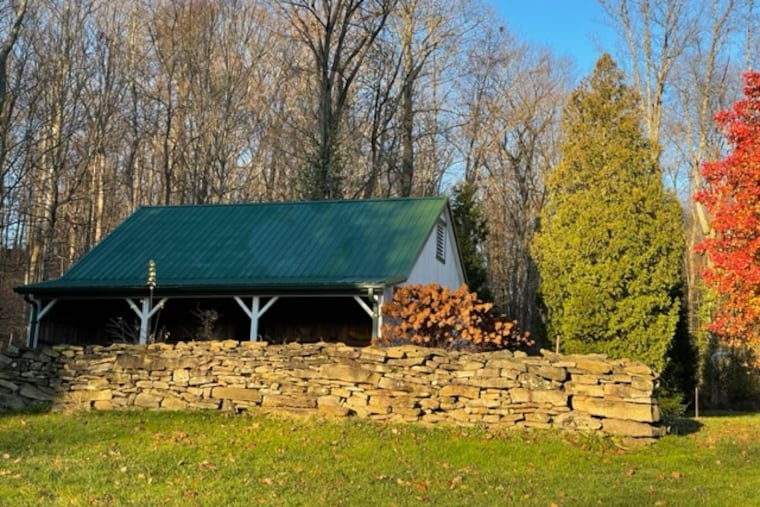What I learned from my compost heap
This fall, a broken tractor forced me to slow down, to pay attention, and meditate on soil brimming with life.

Of all the jobs I do in my garden — hoeing, sowing, weeding, mulching — the one I always avoided was turning the compost heap. Ours is huge and the task is backbreaking. Whenever our friend with a backhoe came to help us with a farm chore, I whispered: “Might you sneak over and turn the compost?”
But then my husband redesigned it so the tractor bucket could fit inside and do the heavy lifting for us. He surrounded the pile with a concrete retaining wall, which he faced with stones he hauled out of the woods. Now when we look at the compost heap from the kitchen window, it resembles a lovely New England stone wall.
But last summer, the tractor broke and in autumn, it still sat in the shop. I needed compost for the usual fall transplanting, but more so this year because my plants had been stripped of topsoil. In August, we had yet another of what we once called “the 100-year flood.” We’ve had about eight of those in the last 15 years, where water cascades down our driveway and turns a stone wall into a waterfall and creates a moat around this old Pennsylvania farmhouse.
Previous floods had come in May, June, and July, but this one was in August, usually our dry month. Making matters worse, we’d just added mulch to the gardens, which was carried downstream into the pond.
Our compost heap includes leaves, grass clippings, kitchen scraps, shrub trimmings, chicken and horse manure, dog hair, tea leaves, cardboard, and newspaper. I read recently that dryer lint could be included, so I add that now.
Every time I dump in an armful of shredded cardboard or a bucket of coffee grounds, I think how fortunate I am to be able to put back into the earth waste that others toss into garbage cans. I love that I don’t add as much to the landfill — and that my detritus turns into “black gold” strikes me as some sort of marvel. But during the tractor’s absence, weeds had taken over and we’d tossed on top mounds of pumpkin, nasturtium, and morning glory vines, making the pile harder to turn by hand.
There must be a compost god because recently, an old friend came to visit. His car broke down and, worrying that he was overstaying his welcome, offered to help out around the farm. I loaned him some muck boots and on a fine autumn day, we climbed atop what had become a compost mountain. He had a fork, I had a shovel, and as we dug, lifted, turned and groaned, we shared memories of a college semester in Paris. There’s something about manual labor that cements a friendship.
When he left, I was on my own. Just three dogs and I mucking around in dirt. One thing I could do that a tractor couldn’t was remove errant rubber bands, terra-cotta pot shards, fruit tags, and plastic plant markers. Temperatures cooled and the leaves turned red and yellow. A pileated woodpecker swooped overhead. One evening I stood still to listen to a great horned owl call from the hilltop.
I grabbed a handful of loamy, moist soil, crumbled it in my hand, and smelled it — purposely breathing in geosmin, an earthy scent believed to be calming, as psychiatrist Sue Stuart-Smith writes in The Well-Gardened Mind. There was no tractor noise, no use of fossil fuel. I was happy out there, helping to create soil. But I was just a small player on a bigger stage.
The real work was being done by the decomposers below my feet: the beetles, millipedes, snails, slugs, ants, and the earthworms, which Aristotle called the “intestines of the soil.” Those that chew, shred, decompose, excrete, tunnel, aerate — all while nourishing our soil.
My favorites are pill bugs, not insects at all, but crustaceans that live their entire lives on land, breathe through gills, and have seven pairs of legs. And that’s not all; there was an entire ecosystem I couldn’t see with the naked eye, microorganisms such as bacteria, nematodes, fungi, springtails, and mites, working their magic.
I interviewed John Wenzel, an entomologist at the Conemaugh Valley Conservancy, about the creatures that live in my compost heap. “Without those organisms, leaves would just be dead leaves and would never turn into soil,” he told me. “We wouldn’t have a terrestrial environment we recognize without them.”
This fall, a broken tractor forced me to slow down, to pay attention, and meditate on soil brimming with life. What these tiniest of creatures do for us seems nothing short of a miracle, and I, for one, am grateful.
We ask so much of them, yet how do we treat them in return? We dump pesticides on them. Insecticides. Herbicides. And fertilizers. I rototill.
What would they say, I wonder, if they could speak? What might they ask of us?
Daryln Brewer Hoffstot is a freelance writer. Her book “A Farm Life: Observations From Fields and Forests” was published recently by Stackpole Books.